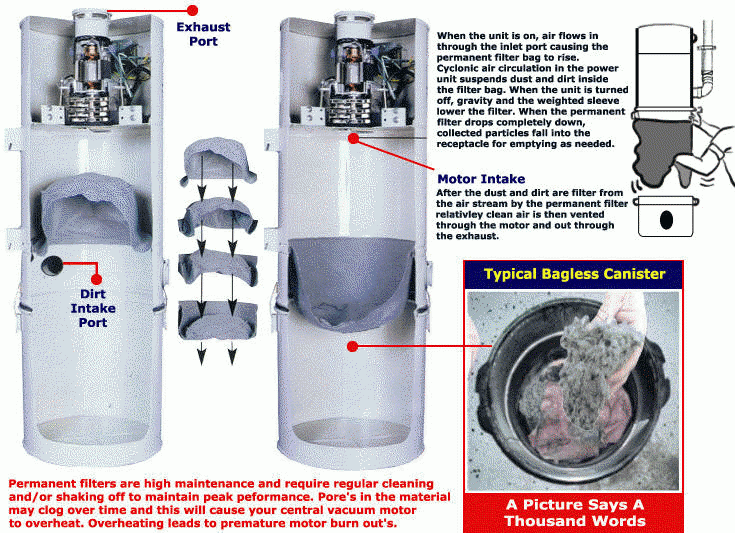Buying Guide: Bag or Bagless Central Vacuum Systems?
Table of contents
Since its introduction in the late industry, the vacuum cleaner has been a crucial appliance in both residential and commercial cleaning. Not only are vacuums ideal for cleaning up dust and debris on the ground, but many models also come with accessories such as power wands that enable you to clean curtains and upholstery. The kind of vacuum cleaner required will change from job to job and from room to building.
For example, a powerful upright vacuum like the Miele Dynamic U1 PowerLine Upright Vacuum might be fantastic for a home. On the other hand, you might want something a little more heavy-duty like the Drainvac DVDC40 Central Vacuum System if you're cleaning many rooms in an office or commercial setting.
Residential vs. Commercial Vacuum Cleaners
 Residential vacuum cleaners usually are lighter and easier to maneuver around than bigger commercial models. They come in a variety of diverse forms and builds, such as the canister or upright styles.
Residential vacuum cleaners usually are lighter and easier to maneuver around than bigger commercial models. They come in a variety of diverse forms and builds, such as the canister or upright styles.
Most models are also quite versatile, boasting the capability to clean carpets and bare floors. Maintenance and upkeep can vary from larger models too.
For example, it might be cheaper or easier to fix a residential model, but how frequently in needs work will greatly depend on upkeep.
This includes things like often changing the bag or filter, and being careful to use the proper cleaning techniques and methods.
For example, if a vacuum comes with a brushroll that doesn't robotically switch off from surface to surface, you'll want to be aware and not use it on unapproved surfaces.
Besides, commercial vacuum cleaners might last longer or be more durable next to their household cousins.
But when maintenance is necessary, the fixes may be more expensive than those of a residential model. Due to their size and power, commercial vacuum cleaners will typically be more costly.
This is in part due to them just being a more specialized type of cleaning appliance. It's always popular for commercial cleaners to be energy efficient.
This is because businesses that purchase and use these large, commercial units are frequently concerned about energy costs. Vacuum manufacturers know this and need to cater to those interested in saving electricity and energy, which saves money.
Of course, the major difference between commercial and residential vacuum cleaners is the performance. A commercial vacuum cleaner is going to be a lot more powerful and heavy-duty than a normal residential model. This is mostly since commercial vacuums are utilized in environments that require more power. For example, someone in the market for an industrial vacuum will be looking to clean whole office floors or warehouses, not just a living room and child play-area. Often this can mean that commercial vacuums come with long power cords, more on-board tools, and larger debris storage capacity.
Bagged vs. Bagless Vacuum Cleaners
Regardless of what capacity you'll be using the vacuum in, you should know the general variance between bagged and bagless vacuums. Each has its own advantages and disadvantages that should be carefully weighed when picking out which variation to go with. Vacuums that use a bag to store dirt and debris have been around a lot longer than their bagless counterparts.
 Bagged vacuums usually mean less maintenance and cleaning since all you really need to do is keep an eye on the full-bag indicator light. This will light up when the bag becomes complete, alerting you that it's time to switch bags. Bagged vacuums can be especially essential for allergy sufferers if made from HEPA-grade materials. Because of how they've changed, cleaning or switching bags is a relatively easy and clean process in many models. One merely needs to eliminate the full dust bag, toss it, and replace it with a clean, empty one.
Bagged vacuums usually mean less maintenance and cleaning since all you really need to do is keep an eye on the full-bag indicator light. This will light up when the bag becomes complete, alerting you that it's time to switch bags. Bagged vacuums can be especially essential for allergy sufferers if made from HEPA-grade materials. Because of how they've changed, cleaning or switching bags is a relatively easy and clean process in many models. One merely needs to eliminate the full dust bag, toss it, and replace it with a clean, empty one.
The bagless vacuum design hasn't been around nearly as long, but it has become a popular choice. With these kinds of vacuums, it's imperative to stay on top of the cleaning process. Since there is no main dirt-bag, you'll have to ensure you keep the filters clean and the dust cup as empty as possible. Bad filters or a full dust cup can actually hurt the performance of your bagless vacuum. Also, many bagless vacuums are multi-cyclonic, meaning that they accurately drop out filter-clogging debris from the airstream to keep the vacuum free of clogs. Note that with bagless vacuum cleaners, you need to be a bit more cautious when emptying them. This is simply because the procedure involves cleaning the filters and dumping the dust cup.
Bag or Bagless?
By now, you have the information you need to begin a well-informed and productive exploration of the vacuum(s) of your dreams. It's always best, to begin with, a type and cleaning work in mind. You'll learn even more about these iconic cleaning appliances, and in time, who knows? You may be able to turn the chore of vacuuming into a choice action to do around the household. Explore our bagged and bagless vacuum options and choose the best for you.




Log In
Create New Account